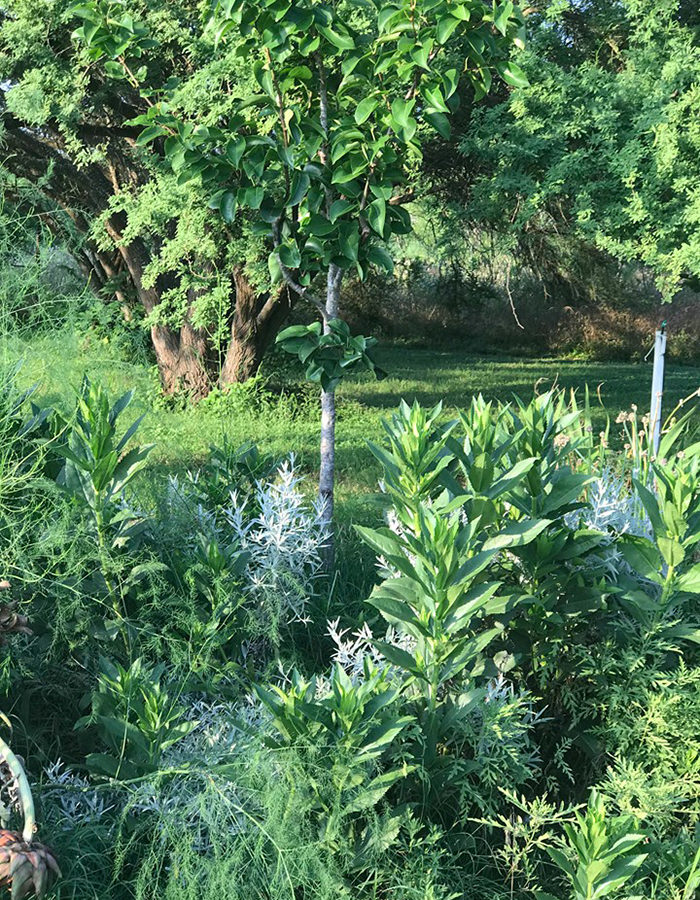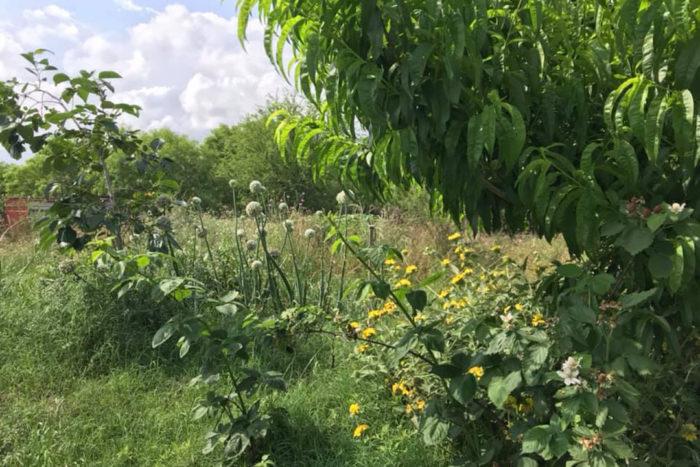
Many gardeners have heard of the “three sisters,” a traditional example of companion planting for corn, beans, and squash. Fewer gardeners are familiar with the concept of a plant guild, which is basically companion planting taken to the next level. A plant guild is an association of plant species clustered around a central element (often a tree) that act together to maintain the health of that central element. Plant guilds are not so much about the specific plants themselves but more about the relationships between them and the services they provide. Fruit trees are great candidates for “guilding,” and there are many supporting plants that are appropriate for fruit tree guilds in the Southern Plains.
When planning a fruit tree guild, we need to select plant species for the following roles: the fruit tree itself, grass-suppressing bulbs, dynamic accumulators, nitrogen fixers, and insectary plants. Here is an explanation for each of these five elements and some suggestions for species appropriate to the Southern Plains region.
Fruit trees
The fruit tree itself is the central element of the guild, and the other species will be working to support it. Suitable fruit tree species for our area include:
- Fig (Ficus carica ‘Celeste’, ‘Brown Turkey’, Zones 6–9)
- Peach (Prunus persica ‘TexStar’, ‘Spring Gold’, ‘June Gold’, Zones 5–8)
- Pear (Pyrus communis ‘Kieffer’, ‘Moonglow’, ‘Orient’, Zones 4–8)
- Persimmon (Diospyros virginiana ‘Eureka’, ‘Hygiea’, ‘American’, Zones 4–9)
- Plum (Prunus salicina ‘Methley’, ‘Santa Rosa’, ‘Ozark’, Zones 5–9)
- Pomegranate (Punica granatum and cvs., Zones 6–11)
- Mulberry (Morus alba × rubra ‘Shangri-La’, Zones 6–11)
Don’t forget that nut trees are technically fruit trees, so you may consider pecan and walnut as possible candidates.

Grass-suppressing bulbs
Almost all cultivated fruit trees thrive with bulb-oriented ground covers instead of grasses. Grasses have shallow root systems that rob nutrients and water from young fruit trees. Guilds reduce root competition from invasive grasses, in part by incorporating bulbs around the tree. Flowering bulbs such as bulbous iris (Iris spp. and cvs., Zones 3–8), crinum lily (Crinum spp. and cvs., 9–11) and alliums (Allium spp. and cvs., Zones 3–9) are beautiful and useful when planted in a ring around the central fruit tree. The alliums (often onions, garlic, or leeks) are also edible and repel pests such as rabbits and deer, who don’t like their smell. Good allium species for our area include:
- Leeks (‘American Flag’, ‘Dawn Giant’, ‘King Richard’)
- Onions (‘Vidalia’, ‘Texas Supersweet’)
- Shallots (‘French Red’, ‘Dutch Yellow’)
Dynamic accumulators
The plants that serve this role in the guild are soft-leaved herbaceous plants whose deep taproots mine minerals from different soil levels and incorporate those minerals into their tissues. When cut down and left in place, the leaves turn to compost that enriches the soil around them, providing the fruit tree with a mineral boost. These dynamic accumulators are nearly always prolific and easy to grow. They include:
- Artichoke
- Borage (Borago officinalis, Zones 2–11)
- Chicory (Cichorium intybus var. sativum, Zones 3–9)
- Comfrey (Symphytum spp. and cvs., Zones 4–8)
- Curly dock (Rumex crispus, Zones 4–8)
- Dandelion
- Radishes
- Sunflower (Helianthus spp. and cvs., Zones 2–11)
- Turnip
- Yarrow (Achillea millefolium and cvs., Zones 3–8)
Nitrogen fixers
Nitrogen-fixing species such as legumes are able to take nitrogen from the atmosphere and incorporate it into their own biomass. When the plant dies, this nitrogen is left in the soil and enriches the soil. These species help to provide a young fruit tree with additional nitrogen for spring growth. There are a number of nitrogen-fixers that grow very well in the Southern Plains, including:
- Alfalfa (Medicago sativa, Zones 4–8)
- Bush beans (‘Contender’, ‘Provider’, ‘Bush Kentucky Wonder’, ‘Burpee Stringless’)
- Clover (especially the white clover ‘Silver River’)
- Lupines (Lupinus, spp. and cvs., Zones 4–8)
- Southern peas (‘Pinkeye Purple Hull’, ‘Brown Crowder’, ‘Big Red Ripper’, ‘Mississippi Silver’)
- Soybeans (‘Beer Friend’)
- Vetch

Insectary plants
The final component in a fruit tree guild is an especially showy one: plants that attract beneficial insects that help combat pest species on our central fruit tree. Any vigorous herbaceous plant that provides nectar, serves as a larval food source, or provides habitat for beneficial insects is useful. Common species for this element of the guild include culinary herbs such as:
- Thyme (Thymus vulgaris, Zones 5–9)
- Cilantro (Coriandrum sativum, annual)
- Dill (Anethum graveolens, Zones 2–11)
- Fennel (Foeniculum vulgare, Zones 4–9)
- Mint (Mentha spp. and cvs., Zones 4–8)
- Oregano (Origanum vulgare, Zones 4–8)
- Parsley (Petroselinum crispum, annual)
- Sage (Salvia officinalis, Zones 4–8)
All of these herbs do well in our climate, some as warm-weather crops and some as cool-weather ones. Other options are:
- Bee balm (Monarda didyma and cvs., Zones 4–9)
- Carrot
- Horseherb (Calyptocarpus vialis, Zones 7–11)
- Lemon balm (Melissa officinalis, Zones 4–9)
- Mealy blue sage (Salvia farinacea, Zones 8–10)
- Mugwort (Artemisia vulgaris, Zones 3–8)
- Obedient plant (Physostegia virginiana, Zones 3–9)
- Thoroughwort (Conoclinium greggi, Zones 7–10)
There is no single formula for a good fruit tree guild, but experimenting with combinations of plants from these five groups can really benefit fruit trees, especially in the first few years of their establishment. Fruit trees planted as part of a guild require fewer inputs such as water and fertilizer, and they are better protected against pest problems. Plus, the layered, multitiered look of a fruit tree guild is a beautiful sight.
Karen Beaty is a horticulturalist at the Lady Bird Johnson Wildflower Center in Austin, Texas.


















Comments
Log in or create an account to post a comment.
Sign up Log in